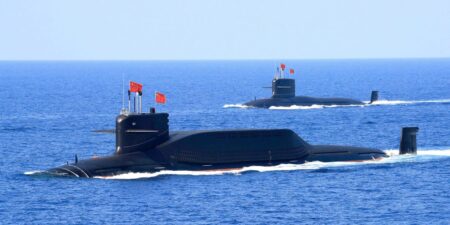Russia used an exploding naval drone to attack a Ukrainian ship this week in what appears to be a first for Moscow’s forces as they look to replicate the success that Kyiv has found with these weapons.
Ukraine has used explosive-packed naval drones throughout the war to attack the Russian Black Sea Fleet. Despite years of watching these operations, there have not been any known instances of Moscow deploying the same capability in combat — until now.
Russia’s defense ministry said on Thursday that it used a “high-speed unscrewed surface vehicle” to attack and sink the Ukrainian Navy medium reconnaissance ship Simferopol at the mouth of the Danube River, which flows into the Black Sea.
Russia published footage that appears to show how the attack unfolded. The drone can be seen slowly approaching the Simferopol and loitering off the side. It then charges at the ship, forcing what looks like several crew members to run. An aerial view then captures a massive fireball in the middle of the river.
The Simferopol, launched in 2019, seems to have been caught off guard by the attack. The vessel has limited defenses aside from a 30mm artillery system.
The Ukrainian Navy acknowledged an attack on one of its ships. A spokesperson said on Friday that at least two crew members had been killed and several sailors were missing or injured. Kyiv did not confirm the time or location of the strike or the status of the Simferopol.
Business Insider could not independently verify the footage or the details of the attack. It is not immediately clear what type of drone was used or where it was launched from.
The attack, nonetheless, is a major development for Russia, as naval drone warfare had long been a lopsided concept in favor of Ukraine.
At the start of Russia’s full-scale invasion in early 2022, Ukraine possessed a limited navy, its fleet mostly consisting of patrol boats and coastal ships. To project power in the Black Sea and fight back, Kyiv launched an asymmetrical campaign with domestically produced naval drones and missiles targeting Moscow’s ships.
Since then, Ukrainian drone boat operations have damaged or destroyed dozens of Russian warships and naval vessels, and forced the wounded Black Sea Fleet to relocate away from its long-held headquarters in the occupied Crimean peninsula to the port of Novorossiysk on the other side of the region. This campaign has been a bright spot for Kyiv amid what has otherwise been a brutal and grinding war, which just eclipsed three and a half years.
Samuel Bendett, a drone expert and an advisor in the Russia studies program at the Center for Naval Analyses, a US-based research institution, said the fact that Moscow can now carry out naval drone attacks is not a surprise considering that it has been studying the Ukrainian operations for years.
Bendett told Business Insider that Russia has developed multiple naval drone variants, adding that the “concept of operations are likely to be heavily influenced by [Ukraine’s] own uses of this technology.” He said it is unclear how the systems are commanded and connected to their operators.
The attack on Ukraine’s Simferopol comes just a few weeks after Russia showcased its naval drone capabilities during a major maritime exercise known as July Storm, using an uncrewed surface vessel to destroy a fake enemy ship. Given the small size of the Ukrainian Navy, though, Moscow’s operations may ultimately have limited strategic value in this war. These capabilities could be a concern for NATO though.
It remains to be seen how Ukraine reacts in the wake of the attack. Russia tried to strengthen its defenses around the Black Sea, including by adding more combat patrol aircraft to better monitor the area. However, Kyiv adapted to these developments by putting surface-to-air missile launchers on its naval drones.
Naval drone warfare is an evolving area of combat that has not been limited to the Black Sea. In the Red Sea, for instance, Iran-backed Houthi rebels have used uncrewed surface vessels to target merchant ships. As a result of the recent operations, Western militaries — including the US Navy — are increasingly training to defend against these threats.
Read the full article here
















